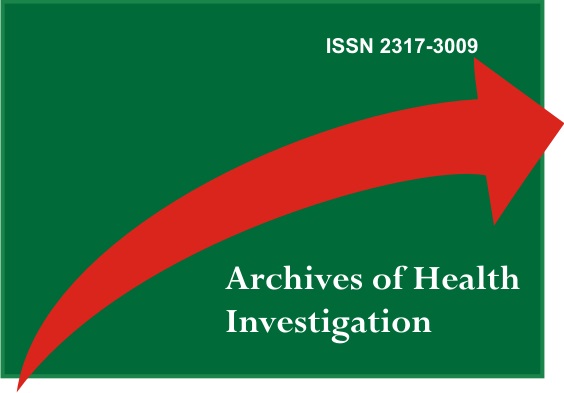Modification of the periodontal phenotype by minimally invasive technique
DOI:
https://doi.org/10.21270/archi.v10i5.4982Keywords:
Periodontics, Gingival Recession, Esthetics, DentalAbstract
The objective of this study was to describe the smile modulation through the tunneling technique with connective tissue graft in the Miller class I root cover. A 24-year-old male patient was referred to the treatment of gingival recession found in the clinical and radiographic examination in element 23, whose height of 2 mm, width of 3 mm and keratinized mucosa of 2 mm. In the consultation, it was chosen to cover it with tunnelled subepithelial tissue graft. Local anesthesia and intra-sulcular incision were performed to be able to subsequently remove the gingiva. With the tunelizador, a muco-periosteal tunnel was prepared and mechanical therapy was performed with Gracey 5/6 curette and chemistry with 10% citric Acid for 3 min, to enable the graft adequacy. The 1.5 mm thick graft was removed from the palate in a linear incision, between the distal element 13 and mesial element 16, 3 mm away from the gingival margin. The tissue was positioned at the site of the recession and maintained by sutures. Cement was made surgical, it was advised not to sanitize the region and to perform a mouthwash with 0.11% Chlorhexidine Digluconate. Adequate planning associated with an excellent execution and predictability technique were fundamental tools for success in the complete coverage of recession and increase of keratinized mucosa.
Downloads
References
Saadoun AP. Current trends in gingival recession coverage--part I: the tunnel connective tissue graft. Pract Proced Aesthet Dent. 2006;18(7):433-8; quiz 440.
Baker P, Spedding C. The aetiology of gingival recession. Dent Update. 2002;29(2):59-62.
Rebele SF, Zuhr O, Schneider D, Jung RE, Hürzeler MB. Tunnel technique with connective tissue graft versus coronally advanced flap with enamel matrix derivative for root coverage: a RCT using 3D digital measuring methods. Part II. Volumetric studies on healing dynamics and gingival dimensions. J Clin Periodontol. 2014; 41(6):593-603.
Tsourounakis I, Sweidan C, Palaiologou AA, Maney P. Coverage of isolated, severe gingival recession: A modified technique. Clin Adv Periodontics; 2014;4:148-53.
Rees JS, Addy M. A cross-sectional study of dentine hypersensitivity. J Clin Periodontol. 2002;29(11):997-1003.
Ribeiro FS, Zandim DL, Pontes AE, Mantovani RV, Sampaio JE, Marcantonio E. Tunnel technique with a surgical maneuver to increase the graft extension: case report with a 3-year follow-up. J Periodontol. 2008;79(4):753-58.
Bouchard P, Malet J, Borghetti A. Decision-making in aesthetics: root coverage revisited. Periodontol 2000. 2001;27:97-120.
Singh J, Rathod VJ, Rao PR, Patil AA, Langade DG, Singh RK. Correlation of gingival thickness with gingival width, probing depth, and papillary fill in maxillary anterior teeth in students of a dental college in Navi Mumbai. Contemp Clin Dent. 2016;7(4):535-38.
Stimmelmayr M, Allen EP, Gernet W, Edelhoff D, Beuer F, Schlee M et al. Treatment of gingival recession in the anterior mandible using the tunnel technique and a combination epithelialized-subepithelial connective tissue graft-a case series. Int J Periodontics Restorative Dent. 2011;31(2):165-73.
Zuhr O,Rebele SF, Schneider D, Jung RE, Hürzeler MB. Tunnel technique with connective tissue graft versus coronally advanced flap with enamel matrix derivative for root coverage: a RCT using 3D digital measuring methods. Part I. Clinical and patient-centred outcomes. J Clin Periodontol. 2014;41(6):582-92.
Miller PD Jr. A classification of marginal tissue recession. Int J Periodontics Restorative Dent. 1985;5(2):8-13.
Dani S, Dhage A, Gundannavar G. The pouch and tunnel technique for management of multiple gingival recession defects. J Indian Soc Periodontol. 2014;18(6):776-80.
Han JS, John V, Blanchard SB, Kowolik MJ, Eckert GJ. Changes in gingival dimensions following connective tissue grafts for root coverage: comparison of two procedures. J Periodontol. 2008;79(8):1346-54.
Zabalegui I, Sicilia A, Cambra J, Gil J, Sanz M. Treatment of multiple adjacent gingival recessions with the tunnel subepithelial connective tissue graft: a clinical report. Int J Periodontics Restorative Dent. 1999;19(2): 199-206.
Shanelec DA. Periodontal microsurgery. J Esthet Restor Dent. 2003;15(7):402-8.
Burkhardt R, Lang NP. Coverage of localized gingival recessions: comparison of micro- and macrosurgical techniques. J Clin Periodontol. 2005;32(3):287-93.
Salama H, Salama M, Garber D. The tunnel technique in the periodontal plastic treatment of multiple adjacent gingival recession defects: A review. Inside Dentistry. 2008;4:78-81.
Zuhr O, Fickl S, Wachtel H, Bolz W, Hürzeler MB. Covering of gingival recessions with a modified microsurgical tunnel technique: case report. Int J Periodontics Restorative Dent. 2007;27(5):457-63.
Allen EP. Subpapillary continuous sling suturing method for soft tissue grafting with the tunneling technique. Int J Periodontics Restorative Dent. 2010;30(5):479-85.
Pfeifer JS. The reaction of alveolar bone to flap procedures in man. Periodontics. 1965;3:135-40.
Pazmiño VFC, Rodas MAR, Cáceres CDB, Duarte GGR, Azuaga MVC, de Paula BL et al. Clinical Comparison of the Subepithelial Connective Tissue versus Platelet-Rich Fibrin for the Multiple Gingival Recession Coverage on Anterior Teeth Using the Tunneling Technique. Case Rep Dent. 2017; 2017:4949710.
Sa TM, Cruz JHA, Guênes GMT, Almeida MSC, Medeiros LADM, Figueiredo CHMC. A importância da anatomia e escultura dental para prática de procedimentos clínicos odontológicos. Arch Health Invest. 2018;7; (Spec Iss 7):6.


